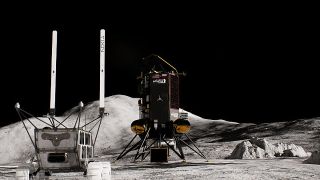Private moon lander will carry Nokia's 4G cell network to the lunar surface this year
The first piece of the network might launch as soon as this year.

Texting on the moon? For future lunar astronauts, that may very well be a possibility.
Nokia is developing a LTE/4G communications system for the moon, and its first piece of the network might launch as soon as late this year. Hardware for a simplified version of the network is due to launch late this year as part of the Intuitive Machine's IM-2 mission, which is anticipated to land at the moon's south pole.
Nokia's equipment, which is essentially a "network in a box," will connect Intuitive Machines' Nova-C lunar lander with Lunar Outpost's MAPP rover and Intuitive Machines' Micro-Nova hopper, testing its viability over both near and far distances.
Related: Astronomers call for radio silence on the far side of the moon
"Like shelter, food and life support, communications will be a crucial component of any future lunar or Mars mission," Thierry Klein, president of Bell Labs Solutions Research at Nokia, said in a statement. "Instead of 'reinventing the wheel' by creating a proprietary network in space, we are taking advantage of the same state-of-the-art technologies that connect billions of smartphones on Earth."
In 2020, NASA awarded contracts to 14 companies to develop "tipping point" technologies to support the Artemis program; Nokia received $14.1 million to build the first cellular network on the moon. Rather than develop all-new technology, Nokia is adapting its existing hardware for the lunar environment.
Should all go according to plan, Nokia's 4G/LTE lunar network would provide more bandwidth than the traditional ultra-high frequency (UHF) systems used for space communication. It would not only make communications quicker from astronaut to astronaut, but also for autonomous robotic systems on the moon. Plus, the network could eventually be adapted for Mars — and upgraded to 5G one day.
Get the Space.com Newsletter
Breaking space news, the latest updates on rocket launches, skywatching events and more!
"Just think about the scale of operations on the moon over the next 20 years. There will be multiple missions in a single year run by different space agencies and even commercial ventures. There will be bases in different regions of the moon," said Klein.
"Having every single mission set up their own communications systems would make no sense economically. Instead, they will need to use the same infrastructure in the same locations and interlink all the different bases on the lunar surface. That is the role of a service provider," Klein added.
But not everyone is thrilled by the idea of a cell network on the moon. Radio astronomers worry that such a network could create radio frequency interference (RFI) that disrupts radio observations.
But there's still hope — operators like Nokia could theoretically protect certain frequencies, leaving radio observatories in the clear.
Join our Space Forums to keep talking space on the latest missions, night sky and more! And if you have a news tip, correction or comment, let us know at: community@space.com.

Space.com contributing writer Stefanie Waldek is a self-taught space nerd and aviation geek who is passionate about all things spaceflight and astronomy. With a background in travel and design journalism, as well as a Bachelor of Arts degree from New York University, she specializes in the budding space tourism industry and Earth-based astrotourism. In her free time, you can find her watching rocket launches or looking up at the stars, wondering what is out there. Learn more about her work at www.stefaniewaldek.com.
